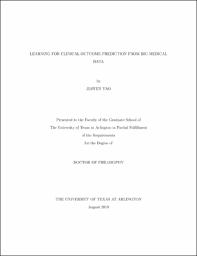
ATTENTION: The works hosted here are being migrated to a new repository that will consolidate resources, improve discoverability, and better show UTA's research impact on the global community. We will update authors as the migration progresses. Please see MavMatrix for more information.
Show simple item record
| dc.contributor.advisor | Huang, Junzhou | |
| dc.creator | Yao, Jiawen | |
| dc.date.accessioned | 2020-08-04T17:33:53Z | |
| dc.date.available | 2020-08-04T17:33:53Z | |
| dc.date.created | 2019-08 | |
| dc.date.issued | 2019-08-09 | |
| dc.date.submitted | August 2019 | |
| dc.identifier.uri | http://hdl.handle.net/10106/29313 | |
| dc.description.abstract | With the advance of recent technological innovations, nowadays scientists can easily capture and store tremendous amounts of different types of medical data such as Computed Tomography (CT), Magnetic Resonance Imaging (MRI), big pathological images and high dimensional cell profiling data. Developing deep learning and machine learning to analyze such large-scale medical data sets for patient health care is an interesting but challenging problem. Inspired by the trend, in this dissertation, we focus on solving real-world problems, like survival analysis on image-omics data and reducing uncertainty from undersampled MRI. Survival analysis is a crucial tool in the clinical study of cancer patients, as it allows clinicians to make early decisions in treatments. With respect to the problem of survival prediction using pathological image data, we first consider to develop a novel image-based pipeline for lung cancer patients. To deal with the subtype cell detection, we develop a deep learning-based detection approach to detect subtype cell locations in images. The proposed pipeline can extract subtype cellular features and describe the tissue organization and structures more effectively than standard cellular imaging features. With respect to the problem of multi-modality integration on image-omics data, the dissertation contributes a novel method for the integration. Previous work have suggested that complementary representation from different modalities provides important information for prognosis. However, due to the large discrepancy between different heterogeneous views, traditional survival models are unable to efficiently handle multiple modalities data as well as learn very complex interactions that can affect survival outcomes in various ways. To overcome these issues, we present a Deep Correlational Survival Model (DeepCorrSurv) for the integration of multi-view data. This results in a more accurate prediction compared with state-of-the-arts methods. With respect to the problem of directly using Whole Slide Images (WSIs) for survival prediction, the dissertation proposes an attention guided deep multiple instance survival learning. Classical methods focus on manually selecting smaller "patches", which seek to represent the WSIs in order to reduce the computational burden. However, these patches are often unable to completely and properly reflect the patients' tumor morphology. Furthermore, the manual annotation work by medical experts required for these methods can often be infeasible to apply to large scale cancer datasets. State-of-the-art WSI-based survival models train patch-based CNN to learn features and then aggregate patch-level results to patient-level decision. However, those models are trained in a unified manner and the aggregation is not trainable. Our model can solve above issues and yield much better predictions than recent WSI-based learning models. Our results also demonstrate the effectiveness of the proposed method as a recommender system to provide personalized recommendations based on an individual's calculated risk. Compared with pathological images, Computed Tomography (CT) and Magnetic Resonance Imaging (MRI) scans can be collected in much faster ways and thus are widely used for masses or tumors surveillance. Dynamic magnetic resonance imaging (dMRI) is one very important medical imaging technique that has been widely used for multiple clinical applications. To achieve clinical outcome prediction using dMRI, the reconstruction is a necessary first step as dMRI scans are originally under-sampled. Without a high quality of reconstruction, it is impossible for later diagnosis. With respect to the problem of dynamic MRI reconstruction, the thesis contributes an efficient algorithm by solving a primal-dual form of the original problem. The convergence rate of the proposed algorithm can be theoretically proved. It is also very convenient to extend to parallel imaging which is more used in recent days. Extensive experiments on single-coil and multi-coil dynamic MR data demonstrate the superior performance of the proposed method in terms of both reconstruction accuracy and time complexity. | |
| dc.format.mimetype | application/pdf | |
| dc.language.iso | en_US | |
| dc.subject | Survival analysis | |
| dc.subject | Deep learning | |
| dc.title | LEARNING FOR CLINICAL OUTCOME PREDICTION FROM BIG MEDICAL DATA | |
| dc.type | Thesis | |
| dc.degree.department | Computer Science and Engineering | |
| dc.degree.name | Doctor of Philosophy in Computer Science | |
| dc.date.updated | 2020-08-04T17:33:54Z | |
| thesis.degree.department | Computer Science and Engineering | |
| thesis.degree.grantor | The University of Texas at Arlington | |
| thesis.degree.level | Doctoral | |
| thesis.degree.name | Doctor of Philosophy in Computer Science | |
| dc.type.material | text | |
| dc.creator.orcid | 0000-0001-7429-2964 | |
Files in this item
- Name:
- YAO-DISSERTATION-2019.pdf
- Size:
- 15.67Mb
- Format:
- PDF
This item appears in the following Collection(s)
Show simple item record


